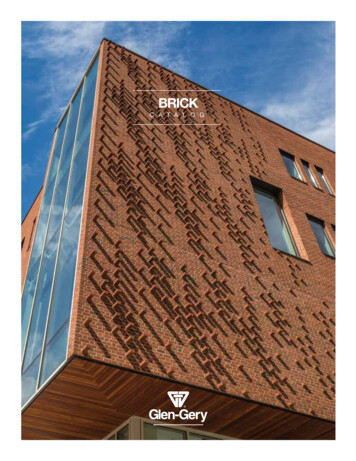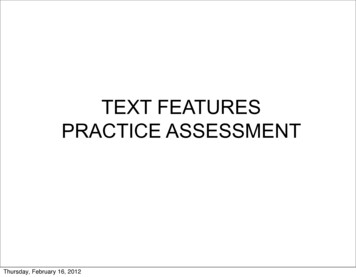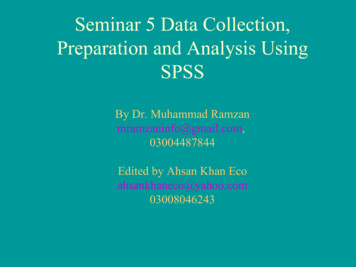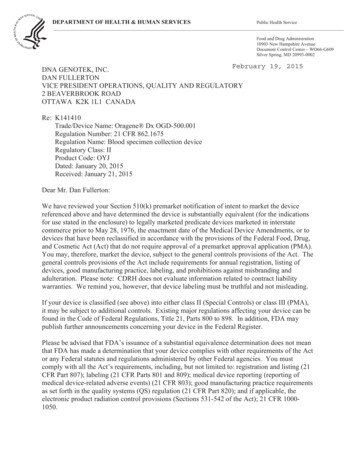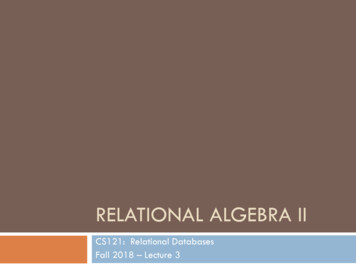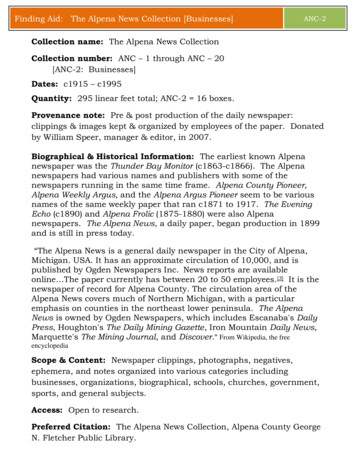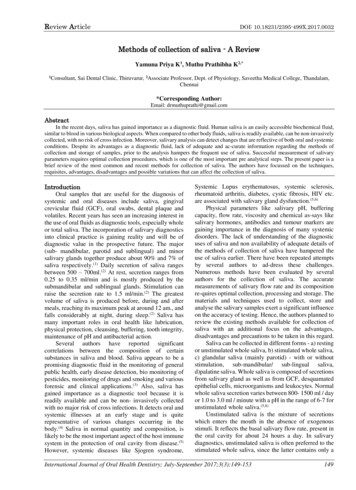
Transcription
Review ArticleDOI: 10.18231/2395-499X.2017.0032Methods of collection of saliva - A ReviewYamuna Priya K1, Muthu Prathibha K2,*1Consultant,Sai Dental Clinic, Thiruvarur, 2Associate Professor, Dept. of Physiology, Saveetha Medical College, Thandalam,Chennai*Corresponding Author:Email: drmuthuprathi@gmail.comAbstractIn the recent days, saliva has gained importance as a diagnostic fluid. Human saliva is an easily accessible biochemical fluid,similar to blood in various biological aspects. When compared to other body fluids, saliva is readily available, can be non-invasivelycollected, with no risk of cross infection. Moreover, salivary analysis can detect changes that are reflective of both oral and systemicconditions. Despite its advantages as a diagnostic fluid, lack of adequate and ac-curate information regarding the methods ofcollection and storage of samples, prior to the analysis hampers the frequent use of saliva. Successful measurement of salivaryparameters requires optimal collection procedures, which is one of the most important pre analytical steps. The present paper is abrief review of the most common and recent methods for collection of saliva. The authors have focussed on the techniques,requisites, advantages, disadvantages and possible variations that can affect the collection of saliva.IntroductionOral samples that are useful for the diagnosis ofsystemic and oral diseases include saliva, gingivalcrevicular fluid (GCF), oral swabs, dental plaque andvolatiles. Recent years has seen an increasing interest inthe use of oral fluids as diagnostic tools, especially wholeor total saliva. The incorporation of salivary diagnosticsinto clinical practice is gaining reality and will be ofdiagnostic value in the prospective future. The major(sub- mandibular, parotid and sublingual) and minorsalivary glands together produce about 90% and 7% ofsaliva respectively.(1) Daily secretion of saliva rangesbetween 500 – 700ml.(2) At rest, secretion ranges from0.25 to 0.35 ml/min and is mostly produced by thesubmandibular and sublingual glands. Stimulation canraise the secretion rate to 1.5 ml/min.(2) The greatestvolume of saliva is produced before, during and aftermeals, reaching its maximum peak at around 12 am., andfalls considerably at night, during sleep.(2) Saliva hasmany important roles in oral health like lubrication,physical protection, cleansing, buffering, tooth integrity,maintenance of pH and antibacterial action.Several authors have reported significantcorrelations between the composition of certainsubstances in saliva and blood. Saliva appears to be apromising diagnostic fluid in the monitoring of generalpublic health, early disease detection, bio monitoring ofpesticides, monitoring of drugs and smoking and variousforensic and clinical applications.(3) Also, saliva hasgained importance as a diagnostic tool because it isreadily available and can be non- invasively collectedwith no major risk of cross infections. It detects oral andsystemic illnesses at an early stage and is quiterepresentative of various changes occurring in thebody.(4) Saliva in normal quantity and composition, islikely to be the most important aspect of the host immunesystem in the protection of oral cavity from disease.(5)However, systemic diseases like Sjogren syndrome,Systemic Lupus erythematosus, systemic sclerosis,rheumatoid arthritis, diabetes, cystic fibrosis, HIV etc.are associated with salivary gland dysfunction.(5,6)Physical parameters like salivary pH, bufferingcapacity, flow rate, viscosity and chemical as-says likesalivary hormones, antibodies and tumour markers aregaining importance in the diagnosis of many systemicdisorders. The lack of understanding of the diagnosticuses of saliva and non availability of adequate details ofthe methods of collection of saliva have hampered theuse of saliva earlier. There have been repeated attemptsby several authors to ad-dress these challenges.Numerous methods have been evaluated by severalauthors for the collection of saliva. The accuratemeasurements of salivary flow rate and its compositionre-quires optimal collection, processing and storage. Thematerials and techniques used to collect, store andanalyse the salivary samples exert a significant influenceon the accuracy of testing. Hence, the authors planned toreview the existing methods available for collection ofsaliva with an additional focus on the advantages,disadvantages and precautions to be taken in this regard.Saliva can be collected in different forms - a) restingor unstimulated whole saliva, b) stimulated whole saliva,c) glandular saliva (mainly parotid) - with or withoutstimulation, sub-mandibular/ sub-lingual saliva,d)palatine saliva. Whole saliva is composed of secretionsfrom salivary gland as well as from GCF, desquamatedepithelial cells, microorganisms and leukocytes. Normalwhole saliva secretion varies between 800- 1500 ml / dayor 1.0 to 3.0 ml / minute with a pH in the range of 6-7 forunstimulated whole saliva.(5,8)Unstimulated saliva is the mixture of secretionswhich enters the mouth in the absence of exogenousstimuli. It reflects the basal salivary flow rate, present inthe oral cavity for about 24 hours a day. In salivarydiagnostics, unstimulated saliva is often preferred to thestimulated whole saliva, since the latter contains only aInternational Journal of Oral Health Dentistry; July-September 2017;3(3):149-153149
Yamuna Priya K et al.diluted concentration of biomarkers, that may be difficultto detect.(7) Nevertheless, the degree of hydration, bodyposture and position of head during collection, exposureto light, drugs and circadian rhythm affect theunstimulated saliva.(8)Stimulated saliva is secreted in response to eithermasticatory or gustatory stimulations. Factors affectingstimulated saliva include gland size, food intake,smoking, gag reflex and type of stimulation given.Stimulated saliva represents the secretion during foodintake (physiological stimulation), and is present in themouth for up to 2 hours.(3) Various stimulants likeparaffin wax, unflavoured chewing gum base, cottonpuff and rubber bands bring about masticatorystimulation, whereas citric acid and sour candy dropsresult in gustatory stimulation. Gustatory stimuli havebeen found to exert a greater effect on salivarycomposition than masticatory stimulants. Mechanical(masticatory) stimulation will not interfere with salivacomposition; however, it is difficult to maintain aconstant force of stimulation (mastication) through-outthe collection period. Standard-size gum base or paraffinwax (1.5 g, mp 42 "C) can be used as a stimulant. Thefrequency of stimulation can be controlled by ametronome at about 70 chews/ min.(9) Stimulants likecitric acid are applied on either side of dorsal surface oftongue.(7,8) Interestingly, pharmacological and electricalstimulants have also been used as therapeutic aids in themanagement of patients with salivary gland hypofunction.(9) Thus, the study of unstimulated salivarysecretion is an accurate method to analyse salivary glandstatus, while stimulated saliva is useful for the study ofthe functional reserve.(10)Methods for collection of saliva per se:Whole Saliva: The authors have personally attemptedvarious methods of collection whole saliva, both instimulated and unstimulated conditions. Whole salivarycollection is easy and non- invasive. It has been found tobe superior and clinically more relevant in theassessment of overall salivary gland dysfunction.(9) But,individual gland secretions are considered to be superiorto whole saliva for many compositional analytes,because whole saliva contains non – salivary elementssuch as desquamated epithelial cells, bacteria, GCF andleukocytes.The methods available presently for collection ofwhole saliva include draining, spitting, suction and swabmethod. Shannon has compared flow rates in a group ofsubjects in different body positions. He reported higherflow rate values in the standing position and lower valuesin the lying position as compared with the flow rate inthe sitting position.(9) Thus, it is ideal to collect saliva,while the subject is sitting upright with the head slightlytilted forward and the eyes open.(11)Draining Method:The subject is made to sit quietly with the head bentdown and the mouth open to allow the saliva to drippassively from the lower lip into the graduated sterileMethods of collection of saliva - A Reviewtubes. (Fig. 1) Saliva collected by draining is without anystimulation and is more reliable.Fig. 1: Draining MethodSpitting Method: Saliva is allowed to accumulate in thefloor of the mouth and the subject spits out it into the preweighed or graduated test tubes. (Fig. 2) The advantageof this method is that it can be used when the flow rate isvery low and where evaporation of saliva has to beminimised. The disadvantage is that it might have somestimulatory effect, and hence cannot be used for unstimulated saliva collection.(5,8)Fig. 2: Spitting MethodSuction Method: Saliva is allowed to accumulate in thefloor of the mouth and aspirated continuously usingmicropipettes, syringes, saliva ejector or an aspirator.(5)Swabbing Method: It is performed by introducing asynthetic gauze sponge, pre-weighed swab or cotton padinto the mouth, at the orifices of major salivary glands.The subjects are asked to chew such that the sponge getssoaked within the saliva. Saliva soaked sponge isremoved and placed in a sterile test tubes. Though thismethod is less reliable, it helps in the assessment of thelevel of oral dryness. It is mainly used in the monitoringof drugs, hormones or steroids.(5)International Journal of Oral Health Dentistry; July-September 2017;3(3):149-148150
Yamuna Priya K et al.Gland Specific / Glandular SalivaGlandular saliva is collected from a specific site ofthe oral cavity. It includes parotid saliva, submandibular/sublingual saliva and secretions from minor salivaryglands.(9)1. Parotid saliva: The parotid duct opening is locatedon the buccal vestibule, opposite to the first andsecond molars. Unstimulated parotid salivary flowis very low or even absent; hence it is collectedunder stimulation. Citric acid solution (2-4%weight/ volume) is used for stimulation. Parotidsaliva is collected using a cannula or Lashley cup ormodified Carlson Crittenden device. (Fig. 3) Thedevice has an outer and inner chamber. The innerchamber is attached to a plastic tubing. The outerchamber is attached to a rubber bulb or a suctiondevice via plastic tubing and the cup is placed overthe ductal opening. The suction device used may bedental suction unit, oil-free portable vaccum pumpor laboratory suction bulb.(9) The authors have foundthat an average of 1-1.5 ml of parotid saliva can becollected in 10-15 minutes. It must be noted that theprotein and organic material concentration ofparotid saliva is twice as high as submandibular andsublingual saliva.(12)Methods of collection of saliva - A Review 3.methods and suction methods. The simplest methodfor collection of submandibular saliva is the suctionmethod.(13)Suction method: It is collected by blocking theStensen’s duct using cotton roll or Lashley cup.Then, the saliva which gets accumulated in thefloor of the mouth is aspirated using a syringe ormicropipette or with gentle suctionCannulation: Tapered polyethylene tubing canbe used for cannulation of the Wharton’s duct.The thin duct which is prone to rupture poses tobe the biggest disadvantage of this method.Segregator method: An apparatus capable ofcollecting submandibular and sublingual salivawith masticatory as well as gustatory stimuli hasbeen fabricated and reported. The col-lector isplaced on the lower jaw and the polyethylene tubeconnects the chamber to the collecting tube. Theappliance should possess adequate peripheralsealing and proper retention to minimise theintermixing of submandibular and sublingualsaliva and further eliminate the contamination byparotid saliva. The central chamber collects thesub- mandibular saliva, while the two lateralchambers collect sub-lingual saliva. Theprocedure is time consuming because the devicehas to be fabricated and adjusted on an individualbasis.(5,14)Collection of saliva from minor glands: Salivafrom minor salivary glands includes palatine saliva,buccal and labial saliva. Labial and buccal salivacan be collected using the periopaper / sialopaperabsorbent method. (Fig. 4) The quantity of salivacan be determined by periotron.(9) Palatine saliva iscollected using filter paper (periopaper) or pipettemethod or by a collecting prosthesis.Fig. 3: Collection of saliva from parotid gland usingCarlson Crittenden cupsThe disadvantages of this procedure are that it iscomplex, slow and invasive. It requires skilled personneland expertise, since this is accomplished either bycannulation of the glandular ducts or by the applicationof specific collecting devices to the opening of ducts.Parotid salivary flow rate has been shown to reach itspeak value, seasonally during the winter and showscircadian variation with peaks in the afternoons. Thetime of the day and the year should be thus standardisedfor saliva collection, as it is a potential factor influencingthe flow rates in long-term salivary studies.(9)2. Submandibular/ sublingual saliva: This glandularsaliva can be collected by cannulation, segregatorFig. 4: Sialopaper, used for saliva collection fromminor salivary glandArmamentarium required for collection of wholeand gland specific salivaThe authors have tabulated the armamentariumrequired for collection of saliva for the reader’scomfort. (Table 1, Fig. 5 a-d)International Journal of Oral Health Dentistry; July-September 2017;3(3):149-148151
Yamuna Priya K et al.Methods of collection of saliva - A ReviewFig. 5a: Graduated sterile tubes with conical endFig. 5b: Automated micropipette for aspiratingsalivaFig. 5c: Dental suction tubesFig. 5d: Plastic conical tubes used for collectingsalivaTable 1: Armamentarium required for collection of whole and gland specific salivaWhole salivaParotid salivaSubmandibular/Sublingual secretion1.2.3.50 mL sterile tube and paper/styrofoam cupCrushed ice and containerDistilled water1. Lashley cup fitted with appropriate polyvinyl chlorate tubing. Thisdevice requires suction, which can be provided by a dental unitsuction laboratory suction bulb or oil-free portable vaccum pump.2. Low-affinity conical plastic collection tubes on ice3. Approximately 5 mL of sterile 2% w/v aqueous citric acid solution,stored at room temperature.1. Submandibular and sublingual saliva collector fitted with a sterile100 μL pipette tip and a low-affinity plastic conical collection tube.This device requires suction, which can be provided by a dental unitsuction or oil-free portable vacuum pump2. Distilled water3. Sterile cotton sponges, dental mirror and forceps4. Approximately 5 mL of sterile 2% w/v aqueous citric acid solutionGuidelines for collection of salivaThe subject should be made to sit comfortably in acalm and isolated room. He / she should rinse the mouththoroughly using distilled water or deionized water toremove any food de-bris. The subjects are then asked tospit out the saliva that has been collected in the initial 30seconds. They are also trained to collect the saliva in thefloor of the mouth for whole saliva collection. Highquality polypropylene tubes or vials should be used forcollection.(15) Initial two minutes of parotid salivaInternational Journal of Oral Health Dentistry; July-September 2017;3(3):149-148152
Yamuna Priya K et al.secretion and any type of stimulated saliva should bediscarded, to avoid salivary diluting effect.(2)Collection should be made at a standard time,preferably between 8 to 11 am. The subject shouldpreferably be in the fasting state or two hrs afterbreakfast.(10) The participants should not brush their teethfor a duration of 45 min prior to the sample collection.Denture wearers should remove their dentures prior tosaliva collection.(15) Dental work or oral ex-aminationshould not be performed within 24 hrs prior to the samplecollection.(16) Partici-pants should be screened for anyoral health problems or injuries. Visibly contaminatedsamples with blood should be discarded. The subjectsshould avoid smoking for at least two hours prior tosaliva collection.Recent techniques of collection of salivaNewer techniques are mostly modifications of theexpectoration methods. A few of them include Oragene,Saligene, Oracol and Verofy. Orageneis the mostsophisticated technique, where preservatives are addedto protect the sample integrity. Using this method, 0.5mlof saliva can be collected and used in geneticanalysis/testing.(16,17) Saligene is an alternative techniquewhich uses collection tubes into which saliva isexpectorated for a predetermined volume, followingwhich a plunger is placed to cap the tube.Oracol, on the other hand, is based on salivacollection through an absorbent foam swab, which picksup 1 mL of saliva. Once the saliva has been taken, it issecure within the container. A micro tube is incorporatedwithin the device, so that the saliva is centrifugeddirectly into the final container. This reduces the risk ofaerosol contamination. This is particularly beneficialwhen used in the field, where laboratory facilities are notavailable.(16,17) Oracol is used in salivary diagnosis ofmeasles, human immunodeficiency virus (HIV),hepatitis A and B, mumps and rubella. Verofy is a uniquemethod which utilises high quality immunochromatographic strips for delivery of immediateresults.(16)With more sensitive and standardised techniquesand standard reference values, salivary diagnostics isgaining promise as a technique of choice presently.Recent advances in methods of salivary collection anduse of multiplex assays that are versatile, sensitive,specific, rapid, cost effective for broad implementationin diagnostic programs makes the future of salivarydiagnostics to appear very promising.Methods of collection of saliva - A mann BG, Park NJ, Wong DT. Genomic targets insaliva. Annals of the New York Academy of Sciences.2007 Mar 1;1098(1):184-91.Shital Hunggund, Jeeth Rai. Saliva as a Diagnostic Aid inperiodontitis. Journal of Pacific Academy of highereducation; 2010; vol:2: issue1 : 59-62.Lee JM, Garon E, Wong DT. Salivary diagnostics.Orthodontics & craniofacial research. 2009 Aug1;12(3):206-11.Navazesh M, Kumar SK. Measuring salivary flow:challenges and opportunities. The Journal of the AmericanDental Association. 2008 May 31;139:35S-40S.Daniel Malamud D. Saliva as diagnostic fluid. Br Med J.1992; 305: 207-18.Rantonen P. Salivary flow and composition in healthy anddiseased adults. Panu Rantonen; Helsinki, 2003.Navazesh M. Methods for collecting saliva. Annals of theNew York Academy of Sciences. 1993 Sep 1;694(1):72-7.FenolI-Palomares C, Munoz-Montagud JV, Sanchiz V,Herreros B, Hernández V, Minguez M, Benages A.Unstimulated salivary flow rate, pH and buffer capacity ofsaliva in healthy volunteers. Revista espanola deenfermedades digestivas. 2004 Nov 1;96(11):773-83.Shannon IL, Chauncey HH. A parotid fluid collectiondevice with improved stability characteristics. Journal oforal therapeutics and pharmacology. 1967 Sep;4(2):93-7.Morales I, Dominguez P, Lopez RO. Devices for salivacollection from the major salivary glands. Results innormal subjects. Revista Medica de Chile. 1998May;126(5):538-47.Basil L, Hanriques DMD. A Modified method for thecollection of human submandibular and sublingual saliva.14(9):124-129.Schneyer LH. Method for the collection of separatesubmaxillary and sublingual salivas in man. Journal ofdental research. 1955 Apr;34(2):257-61.Panchbhai AS. Correlation of salivary glucose level withblood glucose level in diabetes mellitus. Journal of oral &maxillofacial research. 2012;3(3):e3.Senthamil Sindu. Saliva: A Cutting Edge in DiagnosticProcedures. Journal of oral dis-eases 2.Kumar GS. Orban's oral histology & embryology. ElsevierHealth Sciences; 2014 Feb 10.Carda C, Mosquera-Lloreda N, Salom L, Gomez deFerraris ME, Peydró A. Structural and functional salivarydisorders in type 2 diabetic patients. Medicina OralPatologia Oral y Cirugia Bucal. 2006 Jul 1;11(4):209.International Journal of Oral Health Dentistry; July-September 2017;3(3):149-153153
methods and suction methods. The simplest method for collection of submandibular is the suction method.(13) Suction method: It is collected by blocking the Stensen's duct using cotton roll or Lashley cup. Then, the saliva which gets accumulated in the floor of the mouth is aspirated using a syringe or micropipette or with gentle suction

